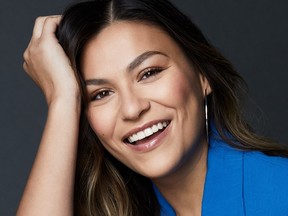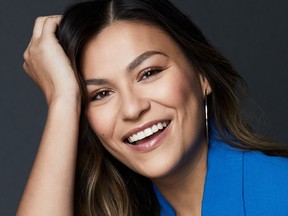The journalist from Frog Lake First Nation is the first Indigenous presenter for CTV’s entertainment news show, a job that’s been a long-held dream for her

Reviews and recommendations are unbiased and products are independently selected. Postmedia may earn an affiliate commission from purchases made through links on this page.
Article content
eTalk’s recent hiring of Michaella Montana as its first Indigenous full-time host was a big, head-turning win for First Nations representation in mainstream broadcast media.
Besides being a first for CTV’s national entertainment news show, it was also the Frog Lake First Nation, Edmonton-born journalist’s dream for years — hoping to literally change the narrative.
Advertisement 2
Article content
Article content
Dedicated broadcasters like the innovative Aboriginal Peoples Television Network or the amazingly freewheeling local 89.3 The Raven aside, there’s long been a scarcity of Indigenous voices and faces on the big networks outside of specialized programming.
“The entertainment stuff, a lot of these show that young people watch, growing up I didn’t see any Indigenous people on these talk shows,” says Montana from Toronto. “So there’s no Indigenous representation. But they’re also not talking about Indigenous things. You’re going to have a talk show in Canada and not talk about the real, original people of Canada?
“It’s just like, ‘Hellooo, we do exist and we are here!’”
Recommended from Editorial
Montana says other domains — specifically the arts — have generally been a step ahead in terms of Indigenous representation, citing some of her on-screen heroes growing up.
“Actors — 100 per cent,” says Montana. “The OGs like Tantoo Cardinal, Graham Greene — I actually remember him from Dudley the Dragon, he was just a crabby apple tree,” she laughs fondly. “But at the time, as a kid, I didn’t realize, ‘Oh that’s an Indigenous person.’”
Article content
Advertisement 3
Article content
Montana’s hopeful the paradigm appears to be shifting, including with her new gig.
“Since I’ve been working with eTalk we’ve covered so many Indigenous stories and TV shows and movies. We didn’t have anything like that growing up, so now to see it as an adult, it’s like, ‘Finally!’”
A child model and actor who appeared in the Canadian supernatural drama Rabbit Falls and hosted the APTN paranormal investigator series The Other Side, Montana endured major bumps in her career including — like her mother — fleeing town from an abusive relationship, confidence and hope in tatters.
But a longtime mentor, First Nations actress/producer Jennifer Podemski, helped Montana stay on course.
After a Nordstrom modelling campaign saw Montana up on a billboard in Toronto’s Dundas Square, she laser-focused to get exactly where she is today.
“I used that as an opportunity to call out a lot of television networks and media outlets,” says Montana. “I basically said, ‘You have every ethnicity on TV right now but an Indigenous person.’”
Asked by a fashion reporter at the time what she’d like to do next, she said wanted to be the first Indigenous eTalk host. Not long after, she got an invite into the office.
Advertisement 4
Article content
“It was very intimidating,” Montana laughs while reflecting. “It was basically, ‘So why do you think you’re good enough?’”
Montana didn’t get the job, but a year later was asked to be a guest contributor, which she did for three years.
When co-host Chloe Wilde headed off on maternity leave, Montana was hired to fill in.
On the show, she specifically pitches Indigenous stories whenever she can.
“It’s hard to not put myself in the box,” says Montana. “But when you’re the only person here doing it, I don’t really have a choice, right?
“Recently, there’s been a lot of talk about Indigenous stars in the show, you know, about (Marvel’s) Echo, about Lily Gladstone and Killers of the Flower Moon.
“We bring up different debates on these shows and I get to have my own commentary, which is sweet — so it’s not just interviews and features, but it’s actually part of the daily show, too.”

One of the more recognizable names in Indigenous broadcasting is Ojibway journalist Duncan McCue, a member of the Chippewas of Georgina Island First Nation, who was a reporter for The National and hosted CBC’s Cross Country Checkup between 2016 and 2020 between Rex Murphy and Ian Hanomansing — the first Indigenous person to host a mainstream show on the national broadcaster.
Advertisement 5
Article content
Last year, he left CBC to join Carleton University’s School of Journalism and Communication where he teaches his Reporting in Indigenous Communities course.
Like Montana, seeing people who looked like him on TV as a kid made a difference.
“The first real ‘Indian’ — and I use that term in quotes — I remember seeing was Jesse from The Beachcombers,” McCue, 52, says of actor Pat John, who died in 2022. “Before that was Tonto, right?
“(Jesse) was a real dude who wore work shirts and drove a boat and had long hair. I was only a little guy, but I’m sure that seeing that on television must have clicked the light bulb on in my head that our stories matter.”
As Montana noted, things were a little scarcer on the media side
“What I didn’t have was journalistic role models when I was a student journalist working at a campus newspaper,” said McCue. “There were forerunners before me and (Pulitzer-prize winner) Connie Walker and Michealla … but they didn’t have national exposure.
“And the narrative frames of what was considered to be Indigenous news was very narrow when I started out 25 years ago, either tragedy or conflict.”
Advertisement 6
Article content
“I think you can’t be an Indigenous person in a newsroom or media organization and not feel a sense of responsibility, because there aren’t enough of us,” says McCue. “That’s one of the reasons that I really wanted to focus on education so that we can we can increase the numbers that are in the business.
“So it’s huge what Michealla’s done,” McCue adds. “It tells other young, Indigenous youth they can do this and stay proud of who they are without losing themselves in the mainstream.”
“We’ve been — for so long — not treated as equals, or even human,” says Montana.
But, having recently become a mother, she’s looking to the future as well.
“For us, especially our young ones, it’s important to have positive, leading examples for them to follow,” she says. “It’s also important to have Indigenous people working in this industry who can open doors and keep those doors open.
“Right now, I’m the only Indigenous person here,” says Montana of her dream gig, hoping she can stay on. “I don’t want to be the last.”
eTalk airs weeknights at 7 p.m. on CTV, CTV.ca and the CTV app, and 7:30 p.m. on CTV Two.
Article content


